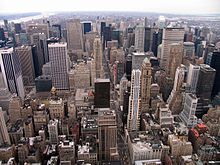নগর ভূগোল

নগর ভূগোল হলো ভূগোলের একটি উপশাখা যেখানে শহর এবং নগর প্রক্রিয়াগুলির অধ্যয়ন মূল আলোচ্য। নগর ভূগোলবিদ এবং নগরবিদগণ[১] নগর জীবনের বিভিন্ন দিক এবং তত্-নির্মিত পরিবেশ নিরীক্ষণ করে। পণ্ডিত, কর্মী এবং জনগণ অংশ নেয়, অধ্যয়ন করে এবং সমালোচনা করে অর্থনীতি ও প্রাকৃতিক সম্পদ, মানব ও মানবেতর সংস্থা, উন্নয়ন ও অবকাঠামোর নিদর্শন, রাজনৈতিক ও প্রাতিষ্ঠানিক কার্যক্রম, শাসন, ক্ষয় এবং পুনর্নবীকরণ, এবং আর্থ-সামাজিক ধারণাগুলিতে অংশ নিয়ে স্থানীয় অন্তর্ভুক্তি, ব্যতিক্রম এবং দৈনন্দিন জীবনে তাদের প্রভাব আলোচিত হয়।
গবেষণার ক্ষেত্র
[সম্পাদনা]নগর ভূগোলবিদরা মূলত নগর ও শহরগুলি কীভাবে নির্মিত হয়, পরিচালিত হয় এবং পরিপূর্ণতা অর্জন করে সে সম্পর্কে আগ্রহী। নগর নৃবিজ্ঞান, নগর পরিকল্পনা ও নগর সমাজবিজ্ঞানের মতো সহ-বিষয়াবলীর পাশাপাশি, নগর ভূগোল সরাসরিভাবে পৃথিবীর পৃষ্ঠের সামাজিক এবং প্রাকৃতিক কাঠামোর উপর নগরের প্রক্রিয়াগুলির প্রভাব অনুসন্ধান করে। নগর ভৌগোলিক গবেষণা মানব ভূগোল এবং প্রাকৃতিক ভূগোল - উভয়েরই অংশ হতে পারে।
ভৌগোলিক দৃষ্টিকোণ থেকে শহর ও নগরীর দুটি মৌলিক বিষয় হ'ল:[২]
- অবস্থান ("শহরের পদ্ধতি"): স্থানিক বিতরণ এবং চলাচলের জটিল নিদর্শন, প্রবাহ এবং সংযোগগুলি যা তাদেরকে মহাবিশ্বে আবদ্ধ করে; এবং
- নগর কাঠামো ("পদ্ধতি হিসাবে শহর"): পরিমাণগত, গুণগত, কাঠামোগত এবং আচরণগত দৃষ্টিকোণ থেকে শহরগুলির মধ্যে বিতরণ এবং মিথস্ক্রিয়াগুলির নিদর্শনগুলির অধ্যয়ন।
গবেষণার বিষয়
[সম্পাদনা]সেবা ও উত্পাদনের কেন্দ্র হিসাবে নগর
[সম্পাদনা]প্রতিটি নগর বিশেষ কিছু সেবা ও উত্পাদনের কাজে জড়িত; নগরে নগরে এক্ষেত্রে ভিন্নতা পরিলক্ষিত হয়ে থাকে।
নগরায়ন
[সম্পাদনা]নগরায়ণ, গ্রাম থেকে শহুরে জনসংখ্যায় রূপান্তর আধুনিক যুগের একটি প্রধান ঘটনা এবং অধ্যয়নের একটি কেন্দ্রীয় বিষয়।[৩]
বিষয় হিসাবে গড়ে ওঠার ইতিহাস
[সম্পাদনা]১৯৭৩ সালে ডেভিড হার্ভের "সামাজিক বিচার ও শহর" (Social Justice and the City) প্রকাশের ফলে নগর ভূগোলের সমালোচনামূলক উপ-শাখা হিসাবে উম্মেষ ঘটে, যা অ্যান বাটিমারের পূর্ববর্তী কাজ দ্বারা ব্যাপকভাবে প্রভাবিত হয়েছিল।[৪] স্বতন্ত্র বিষয় হিসাবে উত্থানের আগে, নগর ভূগোল অন্যথায় পেশাদারী বিকাশ এবং পরিকল্পনা অনুশীলন হিসাবে একাডেমিক বর্ধনের কাজ করেছিল।[৫] উনিশ শতকের শুরুতে, নগর পরিকল্পনা শিল্পায়নের নেতিবাচক পরিণতি প্রশমিত করার পেশা হিসাবে শুরু হয়েছিল ১৮৪৪ সালে ইংল্যান্ডে শ্রমিক শ্রেণির অবস্থার ভৌগোলিক বিশ্লেষণে ফ্রিডরিচ এঙ্গেলস করা আলোচনার মাধ্যমে।[৬]
১৯২৪ সালের নগর ভূগোলের গবেষণায়, মার্সেল অরউসউ দেখেছিলেন যে নগর ভূগোলকে ভূগোলের একটি শাখা হিসাবে বিবেচনা করা যায় না কারণ এটি গুরুত্বপূর্ণ একটি ভূমিকা পালন করে। তবে, দ্বিতীয় বিশ্বযুদ্ধের পরে নগর ভূগোল একটি বিশেষ বিভাগ হিসাবে আবির্ভূত হয়, বর্ধমান নগর পরিকল্পনা এবং ভূগোলের অধ্যয়নের ক্ষেত্রে প্রাকৃতিক অঞ্চলের আধিপত্য থেকে দূরে সরে যাওয়ার মধ্যে। চ্যানসি হ্যারিস এবং এডওয়ার্ড ওলম্যান এর প্রথম দিকের সংগঠকদের মধ্যে অন্যতম।[৭][৮]
নগর ভূগোল ১৯৩০'এর দশকে সোভিয়েত ইউনিয়নে সক্রিয় নগরায়ণ এবং কমিউনিস্ট নগর পরিকল্পনার একাডেমিক পরিপূরক হিসাবে গড়ে ওঠে, যা শহরের অর্থনৈতিক ভূমিকা ও সম্ভাবনার উপর আলোকপাত করে।[৯]
স্থানিক বিশ্লেষণ, আচরণগত বিশ্লেষণ, মার্কসবাদ, মানবতাবাদ, সামাজিক তত্ত্ব, নারীবাদ এবং উত্তর আধুনিকতা (প্রায় এই ক্রমে) পাশ্চাত্যে নগর ভূগোলের ক্ষেত্রে ব্যবহৃত পর্যায়ক্রমিক উচ্চতর ধাপ হিসাবে উদ্ভূত হয়েছে।[১০]
ভৌগোলিক তথ্য বিজ্ঞান, যা বড় ডেটা সেটগুলির ডিজিটাল প্রসেসিং ব্যবহার করে, ১৯৮০'এর দশক থেকে নগর ভূগোলের জন্য বড় সহায়ক ক্ষেত্র হিসাবে ব্যাপকভাবে ব্যবহৃত হয়ে আসছে।[১১]
আরও দেখুন
[সম্পাদনা]তথ্যসূত্র
[সম্পাদনা]- ↑ Soja, Edward W. "Taking space personally." In The Spatial Turn, pp. 27-51. Routledge, 2008.
- ↑ Carter (1995), p. 5–7. "[...] the two main themes of study introduced at the outset: the town as a distributed feature and the town as a feature with internal structure, or in other words, the town in area and the town as area."
- ↑ Carter (1995), p. 17. "This latter fact emphasizes that 'the most conspicuous feature of today's accelerated world population growth is its even greater rapidity of urbanization. In many periods of history, populations have grown, but the tempo and dimensions of recent years have never been equalled' (United Nations, 1969). It follows that urbanization is the predominant process in the spatial organization of the world's population and it is this which makes its geographical study an imperative and perhaps puts the niceties of definition into proper perspective."
- ↑ Buttimer, Anne. "Social Space in Interdisciplinary Perspective." Geographical Review 59, no. 3 (1969): 417-26. doi:10.2307/213485.
- ↑ Hall, Peter. Cities of tomorrow. Oxford: Blackwell Publishers, 1988.
- ↑ Engels, Friedrich. The condition of the working class in England in 1844. London: Allen and Unwin, 1892.
- ↑ Carter (1995), pp. 1–4.
- ↑ Kaplan et al. (2004), p. 4. "The first half of the 20th century saw the gradual emergence of the field of urban geography, which was based on several fundamental concepts developed by a limited number of scholars. The first courses in urban geography were not taught until the 1940s (by Chauncy Harris, the father of urban geography,at Indiana University and by Edward Ullman at Harvard University)> The second half of the 20th century then witnessed the development of urban geography as a major substantive subdiscipline in geography. At the dawn of the 21st century, only the technical field of geographic information sciences had more members in the leading and largest professional geography society, the Association of American Geographers (AAG) than the urban geography group did."
- ↑ G.M. Lappo & N.V. Petrov, Urban Geography in the Soviet Union and the United States; Lanham, Maryland: Rowman & Littlefield, 1992; আইএসবিএন ০-৮৪৭৬-৭৫৬৮-৮; pp. 15–20.
- ↑ Kaplan et al. (2004), pp. 8–11.
- ↑ Kaplan et al. (2004), p. 11–14.
গ্রন্থপঞ্জি
[সম্পাদনা]- Carter, Harold (1995). The Study of Urban Geography. Fourth edition. London: Arnold. আইএসবিএন ০ ৭১৩১ ৬৫৮৯৮
- Kaplan, David H.; James O. Wheeler; Steven R. Holloway; & Thomas W. Hodler, cartographer (2004). Urban Geography. John Wiley & Sons, Inc. আইএসবিএন ০-৪৭১-৩৫৯৯৮-X